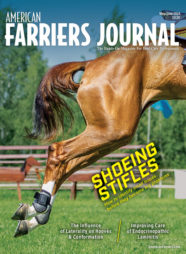Over the weekend, 22 horses competed in the 143rd running of the Kentucky Derby. Like all athletes, these elite Thoroughbreds—under the care of their trainers and owners—must walk the line between rigorous training and injury. And one of the most feared conditions in horses is laminitis.
Andrew van Eps, now an associate professor of equine musculoskeletal research at the School of Veterinary Medicine’s New Bolton Center, was a resident at Penn Vet in 2006 when Derby winner Barbaro was treated there for a broken leg sustained in the Preakness. Although Dean Richardson, Penn Vet’s Charles W. Raker professor of equine surgery, was able to repair the jigsaw-puzzle-like fracture, the New Bolton Center team was not able to spare the horse from the laminitis that followed.
Late last year, van Eps returned to Penn Vet after several years at the University of Queensland in Australia. His focus is on understanding the underlying causes of laminitis and using that knowledge to develop practical treatments. He presented on his research and cutting-edge laminitis therapies this week as part of New Bolton Center’s First Tuesday Lecture series.
“We’ve done a lot of good work over the last 10 years, since Barbaro,” van Eps says. “We know now that there are different mechanisms that can lead to the disease, and we’re working out ways to prevent or ameliorate the different forms.”
There are actually three different types of laminitis, van Eps explains. Barbaro suffered from what is known as support-limb laminitis, where an injury to one leg causes the opposite leg to support more weight than usual, leading to the disease.
Far more common, however, is a form of laminitis triggered by overproduction of insulin.
“It’s a little similar to Type 2 diabetes in people,” van Eps says. “The difference is, people will stop producing insulin, while horses and ponies just keep making it, and that insulin triggers changes in the feet of these animals.”
Laminitis also can arise in horses with systemic disease, such as colitis or sepsis. For this third form, van Eps has made major progress in treatment, using foot cooling, or cryotherapy, to effectively stop and even partially reverse damage in affected animals.
With the supporting-limb form of laminitis, van Eps is partnering with colleagues to develop mechanical interventions that address what they believe to be the root cause of disease, namely disturbances to blood flow that occur when the horse’s ability to cycle weight bearing among its limbs is impaired.
“We’re very excited to use the robotic CT here at New Bolton to do some studies that look at blood flow and weight bearing in standing horses,” he says.
Finally, van Eps is continuing to probe the underlying molecular events that contribute to the metabolic form of disease, including finding potential drugs to block the insulin-triggered pathways that can lead to problems in the foot. He also hopes to test whether the foot cooling method could help in this form of laminitis as it does in horses with systemic illness.
With this multi-pronged attack, van Eps hopes to make a difference to horses of all stripes, from Triple Crown contenders to pastured ponies. And he says a lot of the advancements owe a debt to Barbaro.
“After his case, there has been an exponential increase in interest and funding in laminitis, and we owe a lot to Roy and Gretchen Jackson, his owners,” van Eps says. “Our progress is part of the Barbaro legacy.”
Van Eps will be a featured speaker at the International Hoof-Care Summit on Jan. 23-26, 2018, in Cincinnati, Ohio.







Post a comment
Report Abusive Comment